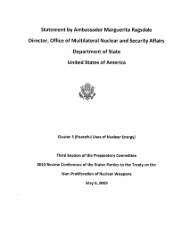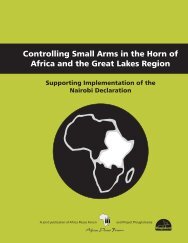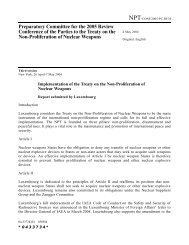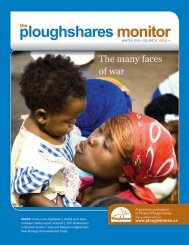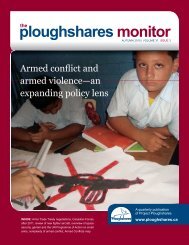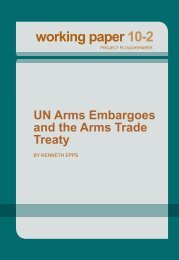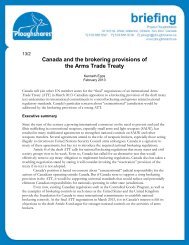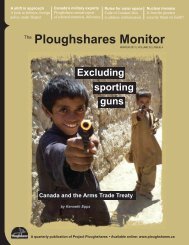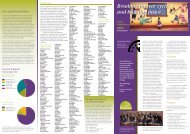Addressing Armed Violence in East Africa.pdf - Project Ploughshares
Addressing Armed Violence in East Africa.pdf - Project Ploughshares
Addressing Armed Violence in East Africa.pdf - Project Ploughshares
Create successful ePaper yourself
Turn your PDF publications into a flip-book with our unique Google optimized e-Paper software.
<strong>Address<strong>in</strong>g</strong> <strong>Armed</strong> <strong>Violence</strong> <strong>in</strong> <strong>East</strong> <strong>Africa</strong>4. UgandaBox 4.2.2. Uganda’s National Action Plan on Small Arms and Light Weapons (NAP)The National Security Committee of Uganda formally approved Uganda’s NAP <strong>in</strong> June 2004 and it was publicly launched <strong>in</strong>September 2005 by the Uganda National Focal Po<strong>in</strong>t on Small Arms and Light Weapons. NAP implementation is <strong>in</strong>cluded as apriority <strong>in</strong> Uganda’s Poverty Eradication Action Plan (PEAP). 1The NAP provides a national framework for the response to the proliferation and misuse of small arms and light weapons <strong>in</strong>Uganda. It also supports national implementation of regional and <strong>in</strong>ternational commitments with regard to small arms control.The NAP sets objectives <strong>in</strong> 10 key areas:1. National Bodies and Agencies2. Policy and Legislation3. Stockpile Management4. Public Education and Awareness Programme5. International and Regional Co-operation and Information Exchange6. Border Control and Refugees7. Human Development Plann<strong>in</strong>g8. Tra<strong>in</strong><strong>in</strong>g and Capacity-Build<strong>in</strong>g9. Research10. Critical Areas of SupportMore <strong>in</strong>formation on the NAP is available from the Uganda National Focal Po<strong>in</strong>t, PO Box 7191, Kampala, Uganda,genpol25@utlonl<strong>in</strong>e.co.ug.1 See Uganda National Focal Po<strong>in</strong>t on Small Arms and Light Weapons, Mapp<strong>in</strong>g the Small Arms Problem <strong>in</strong> Uganda: The Development of Uganda’s National ActionPlan on Small Arms and Light Weapons, Government of Uganda, May 2007, http://www.saferworld.org.uk/images/pubdocs/Uganda_Mapp<strong>in</strong>g.<strong>pdf</strong>In some <strong>in</strong>terviews, the police and other government officialswere cited as data sources. An official <strong>in</strong> Kitgum district toldus that the “police keep records of civilians who have gunlicences”. However, security officials appeared very reluctantto share any data they may have had. In three prearrangedmeet<strong>in</strong>gs, officials decl<strong>in</strong>ed to answer any <strong>in</strong>terview questions,let alone questions about data on weapons possession and use.The f<strong>in</strong>al dimension of the armed violence lens addresses the<strong>in</strong>stitutions, laws and practices <strong>in</strong> a violence-affected context.These are the structures, norms and rules that formally or<strong>in</strong>formally affect levels of violence.InstitutionsThe questionnaires focussed on two areas of <strong>in</strong>stitutional<strong>in</strong>tervention to reduce levels of violence <strong>in</strong> north and eastUganda. Informants were asked to describe methods orprogrammes that were used to control and reduce weapons,and <strong>in</strong> many <strong>in</strong>stances the responses described disarmamentprogrammes of the Ugandan government. More extensively,one section of the questionnaire explored the peacebuild<strong>in</strong>gprogramm<strong>in</strong>g of World Vision <strong>in</strong> the Kitgum and Sorotidistricts. The responses to these questions provided <strong>in</strong>sight<strong>in</strong>to the impact of World Vision <strong>in</strong>tervention and where andhow it affected levels of violence. We consider the governmentprogrammes first.Government <strong>in</strong>tervention: Disarmament programmesThe Ugandan government recently implemented disarmamentprogrammes <strong>in</strong> the Kitgum and Soroti districts. Informantsstated that a government programme <strong>in</strong>volved two stages:an amnesty (a period of voluntary disarmament), followedby enforcement. We also were told that, because guns wereno longer available, a disarmament programme was now notneeded. However, these comments may have arisen from areluctance to admit the local presence and impact of guns.Accord<strong>in</strong>g to one <strong>in</strong>formant, dur<strong>in</strong>g the demobilisation period agovernment programme called for voluntary disarmament andparticipants were given a certificate. Afterwards those caughtwith a weapon were considered “thugs” and prosecuted42



